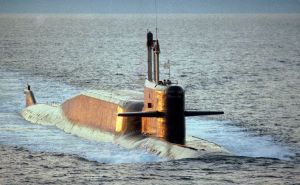The search for a Russian submarine off the coast of Sweden conjures images of Tom Clancy novels, and sheds light on a conflict brewing for generations. The cold war never ended, and it’s more dangerous now than it ever was. The U.S. military is paying attention; the rest of us should, too, for our lives and the lives of our children depend upon it. This is not the time to be slashing our defense spending, and in particular, thinning the ranks of our military by giving the boot to combat veterans and officers with experience in the name of slashing budgets. It’s ludicrous and dangerous. I’ve personally spoken to many active duty personnel who are outraged by these cuts, this purge, and while I at first thought it was some kind of spin, I’m now certain it is true. It scares me. Russia is rising. In the Ukraine, Russia sends in troops under the guise of humanitarian response, ignores the rest of the world, and pursues its own expansionist goals with methodical, ruthless abandon. There is method to their madness.
U.S. fighter jets intercepted Russian bombers off Alaska and California in June, another in a long string of recent potentially deadly aerial encounters. Four long-range Russian Tu-95 Bear-H bombers, accompanied by an aerial refueling tanker, flew into the U.S. Air Defense Identification Zone, an area extending 200 miles from the North American coast, off Alaska, where they were intercepted by U.S. F-22 fighter jets.
Two of the Russian bombers peeled off and headed west, while the other two flew south and were identified by U.S. F-15 fighters within 50 miles of the California coast.
Gen. Herbert “Hawk” Carlisle, in a presentation to the Center for Strategic and International Studies in Washington, said this:
“They’ve come with their long-range aviation off the coast of California; they circumnavigated Guam,” Carlisle said, showing a picture of a U.S. F-15 fighter “intercepting” a Russian bomber off the Pacific island.
In April, a Russian SU-24 fighter jet made a dozen close-range passes by an American warship, the USS Donald Cook, in the Black Sea in what the Pentagon called a “provocative” move while tension continued to ramp up in the region.
Earlier this week, two Canadian F-18 fighter jets intercepted a Russian aircraft over the Baltic Sea, as Russian military activity increased in the area.
in September, NORAD reported that Canadian and U.S. jets scrambled and intercepted six Russian aircraft within the Air Defense Identification Zone, which rings most of North America.
Russia has simulated bombing runs against Sweden, invaded its air space time and time again. Fighter jets swoop in on NATO aircraft, violating both common sense and international law, roll to show off a weapons load, and then stick around until the West scrambles fighters to escort the Russians away.
Why would Russia be doing this? To test response time, of course. To intimidate and bully, certainly. To probe for weakness. What is their long game?
It’s about oil and power.
Recent discoveries of oil and gas under the sea floor in the arctic reveal that the area may contain up to 30% of the worlds oil reserves. Since much of the ice is melting, a new Northern Sea Route, an alternative to the Suez Canal is a real possibility.
Arctic Military Command
The Russian news agency RIA Novosti reports that a 6000 member force of permanent troops will be established in the Arctic region. Russia is reactivating Soviet bases in the area. They annexed an island last week, and are building air strips capable of supporting fighter jets. Russian Defense Minister Sergey Shoigu said on Tuesday, “We have moved into the Arctic rather actively and this year we shall have many units deployed along the Arctic Belt – in fact from Murmansk to the Chukotka Peninsula.” He went on to say,“This is fundamental, large-scale work.”
Russia is shifting it’s fleet, creating a new Northwest Command, which will protect it’s interest in the arctic region. Russian training exercises, including the use of paratroopers, has increased exponentially in the last year.
President Putin announced in September that Russia is developing new nuclear weapons and increasing its offensive capability. Russia’s nuclear deterrent and doctrine is based around the use of a First Strike. The United States has announced it will also increase it’s nuclear capabilities, and is developing weapons capable of striking targets anywhere in the world within an hour. Over the last year, both countries have increased the deployment of nuclear weapons.
Earlier this month, Russia announced it will not renew the twenty-year old Nunn-Lugar Cooperative Threat Reduction Program, which was a crucial partnership between the United States and Russia to dismantle and decommission chemical and nuclear weapons. More than 7,600 warheads were dismantled under that program.
Now, both sides are building more nuclear weapons
The Land Grab
Against this backdrop of threats and volatility and military buildup, a land grab is coming. Russia is going to try for more oil-rich land, and it’s going to happen in the north. They may try to invade one of the Baltic nations, testing NATO’s resolve. Russia could waltz into Sweden or Norway with little conventional resistance. Much of Europe is disarmed, relying on NATO and the United States for defense. But would the U.S. or NATO be willing to use nuclear weapons in that event? If Russia puts boots on the ground, supported by armored divisions and aircraft, how does that war end without one side resorting to the use of weapons of mass destruction? The use of a tactical nuke on a battlefield could lead in seconds to a retaliation and escalation.
There is always hope, and perhaps clear heads will indeed prevail.
I wrote about the outcome of such a conflict in my novel Objects of Wrath. If you are intrigued and terrified by this scenario, please check out my books!





